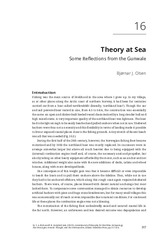| dc.contributor.author | Olsen, Bjørnar Julius | |
| dc.date.accessioned | 2024-01-26T10:47:14Z | |
| dc.date.available | 2024-01-26T10:47:14Z | |
| dc.date.issued | 2023 | |
| dc.description.abstract | Fishing was the main source of livelihood in the area where I grew up. In my village, as at other places along the Arctic coast of northern Norway, it had been for centuries carried out from a boat called nordlandsbåt (literally, ‘northland boat’). Though the oar and sail powered boat varied in size, from 4.5 to 14 m, the construction was essentially the same: an open and clinker-built keeled vessel characterized by a long slender hull and high raised stems. A very important quality of the northland boat was lightness. The boat had to be light enough to be easily beached and pulled onshore when not in use. Sheltered harbors were thus not a necessity and this flexibility in terms of landing made it possible to live at exposed coastal places close to the fishing grounds. A tiny stretch of decent beach was all that was needed. | en_US |
| dc.identifier.citation | Olsen B.J.: Theory at Sea: Some Reflections from the Gunwale. In: Rich, Campbell P. Contemporary Philosophy for Maritime Archaeology:
Flat Ontologies, Oceanic Thought,
and the Anthropocene, 2023. Sidestone Press p. 317-334 | en_US |
| dc.identifier.cristinID | FRIDAID 2191913 | |
| dc.identifier.isbn | 978-94-6427-040-2 | |
| dc.identifier.uri | https://hdl.handle.net/10037/32744 | |
| dc.language.iso | eng | en_US |
| dc.publisher | Sidestone Press | en_US |
| dc.relation.projectID | Norges forskningsråd: 250296 | en_US |
| dc.rights.accessRights | openAccess | en_US |
| dc.rights.holder | Copyright 2023 The Author(s) | en_US |
| dc.title | Theory at Sea: Some Reflections from the Gunwale | en_US |
| dc.type | Chapter | en_US |
| dc.type | Bokkapittel | en_US |


 English
English norsk
norsk